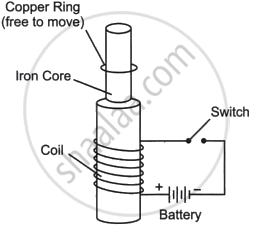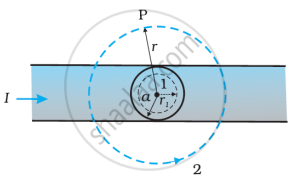Advertisements
Advertisements
प्रश्न
Two concentric and coplanar circular loops P and Q have their radii in the ratio 2:3. Loop Q carries a current 9 A in the anticlockwise direction. For the magnetic field to be zero at the common centre, loop P must carry ______.
विकल्प
3 A in clockwise direction
9 A in clockwise direction
6 A in anti-clockwise direction
6 A in the clockwise direction
उत्तर
Two concentric and coplanar circular loops P and Q have their radii in the ratio 2:3. Loop Q carries a current 9 A in the anticlockwise direction. For the magnetic field to be zero at the common centre, loop P must carry 6 A in the clockwise direction.
Explanation:
Given: The ratio of the radius of the loops P and Q = 2:3
Current in the loop Q = 9 A in (anticlockwise direction)
To Find: The current in loop P for which the magnetic field at the common centre becomes zero.
⇒ The intensity of the magnetic field (B) at the centre of a circular current-carrying coil is given by the formula:
Magnetic Field (B) = `(μ_0i)/(2R)`
- Where 'i' is the current flowing through the circular coil.
- Here 'R' is the radius of the circular coil.
- 'μ0' is a constant known as the permeability constant of free space.
⇒ The direction of the magnetic field due to the circular current-carrying coil is given by the right-hand thumb rule.
According to this law, if we curl our right-hand palm around the current-carrying loop with fingers pointing in the direction of the current flow, then the direction of our right-hand thumb will give us the direction of the Magnetic field.
⇒ In the given question, the current in loop Q is flowing in the anticlockwise direction. Therefore for the resultant magnetic field to be zero at the common centre, the current in the loop P must flow in the clockwise direction.
Let the magnetic field due to the loop P be 'B1'
Let the magnetic field due to the loop Q be 'B2'
Let the current through the loop P be 'i1'
The ratio of the radius of the loops P and Q is R1:R2 is equal to 2:3.
⇒ The magnetic field 'B1' due to the current-carrying loop P is given by:
B1 = `(μ_0i_1)/(2R_1)` – Equation (i)
⇒ The magnetic field 'B2' due to the current-carrying loop Q is given by:
B2 = `(μ_0i_2)/(2R_2)` – Equation (ii)
⇒ Equating the equations (i) and (ii):
∵ B1 = B2
∴ `(μ_0i_1)/(2R_1) = (μ_0i_2)/(2R_2)`
∴ `i_1/i_2 = R_1/R_2`
∴ `i_1 = 2/3 xx i_2`
∴ `i_1 = 2/3 xx 9`
∴ i1 = 6 Ampere
Therefore for the magnetic field to be zero at the common centre, the loop P must carry a current of 6 Ampere in the clockwise direction.
APPEARS IN
संबंधित प्रश्न
Write Maxwell's generalization of Ampere's circuital law. Show that in the process of charging a capacitor, the current produced within the plates of the capacitor is `I=varepsilon_0 (dphi_E)/dt,`where ΦE is the electric flux produced during charging of the capacitor plates.
Explain Ampere’s circuital law.
In Ampere's \[\oint \vec{B} \cdot d \vec{l} = \mu_0 i,\] the current outside the curve is not included on the right hand side. Does it mean that the magnetic field B calculated by using Ampere's law, gives the contribution of only the currents crossing the area bounded by the curve?
A hollow tube is carrying an electric current along its length distributed uniformly over its surface. The magnetic field
(a) increases linearly from the axis to the surface
(b) is constant inside the tube
(c) is zero at the axis
(d) is zero just outside the tube.
Using Ampere's circuital law, obtain an expression for the magnetic flux density 'B' at a point 'X' at a perpendicular distance 'r' from a long current-carrying conductor.
(Statement of the law is not required).
Ampere's circuital law is used to find out ______
A thick current carrying cable of radius ‘R’ carries current ‘I’ uniformly distributed across its cross-section. The variation of magnetic field B(r) due to the cable with the distance ‘r’ from the axis of the cable is represented by ______
Read the following paragraph and answer the questions.
|
Consider the experimental set-up shown in the figure. This jumping ring experiment is an outstanding demonstration of some simple laws of Physics. A conducting non-magnetic ring is placed over the vertical core of a solenoid. When current is passed through the solenoid, the ring is thrown off. |

- Explain the reason for the jumping of the ring when the switch is closed in the circuit.
- What will happen if the terminals of the battery are reversed and the switch is closed? Explain.
- Explain the two laws that help us understand this phenomenon.
The given figure shows a long straight wire of a circular cross-section (radius a) carrying steady current I. The current I is uniformly distributed across this cross-section. Calculate the magnetic field in the region r < a and r > a.

Using Ampere’s circuital law, obtain an expression for magnetic flux density ‘B’ at a point near an infinitely long and straight conductor, carrying a current I.
